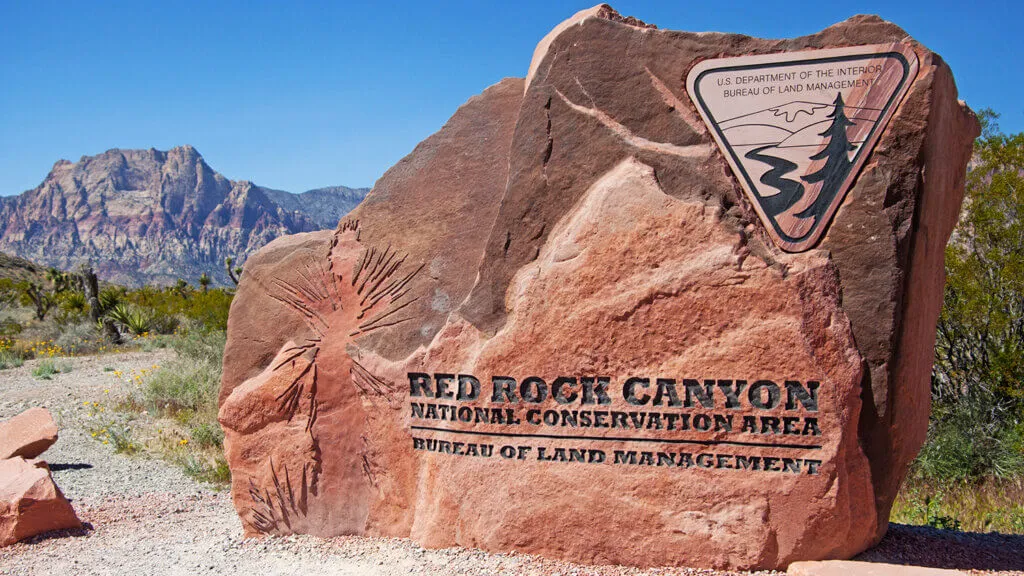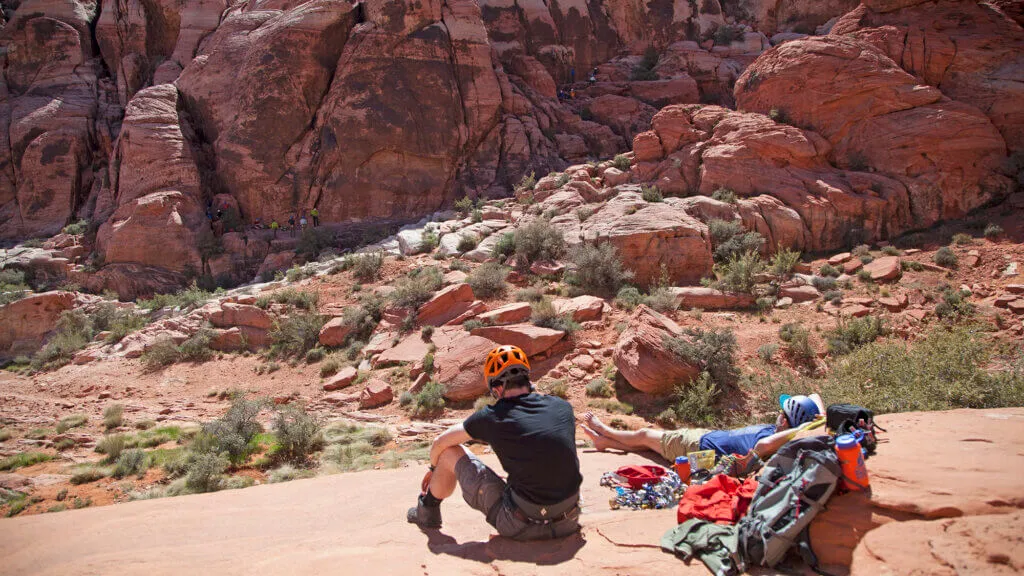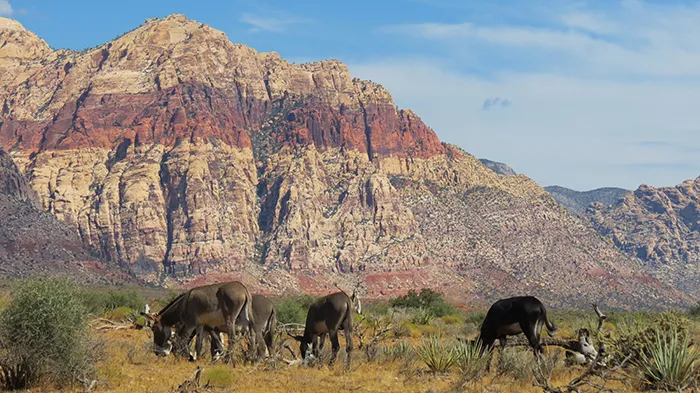Dreaming of a trip to the sunny landscapes of Nevada? Don’t miss Red Rock Canyon, a hidden gem with irresistible wild beauty. However, the Nevada desert is not an easy place to conquer. For a safe and memorable journey, equip yourself with essential survival skills. This article will be a useful guide, helping you explore Red Rock Canyon to the fullest.
Red Rock Canyon: An Emerald Gem in the Nevada Desert
Red Rock Canyon, located in the vast Mojave Desert of Nevada, is a renowned nature preserve famous for its vibrant red rock formations and majestic canyons. Designated as a conservation area since 1990, it’s an ideal destination for those passionate about exploring untouched nature and experiencing challenging outdoor activities. Spanning over 195,000 acres, Red Rock Canyon is not only scenically valuable but also rich in cultural and historical significance from indigenous civilizations.

How to Get to Red Rock Canyon?
Red Rock Canyon is only about 17 miles (27 km) from Las Vegas, a 30-minute drive from downtown. This makes it an extremely convenient destination for those wanting to explore nature near one of the world’s largest entertainment cities. You can rent a car or join guided tours to visit the conservation area. If you’ve planned to visit other notable sites near Las Vegas, such as the Hoover Dam or Lake Mead, Red Rock Canyon can easily be incorporated into your itinerary.
Historical and Cultural Significance
Red Rock Canyon is also a treasure trove of indigenous history and culture. This area was once inhabited by Native American tribes such as the Southern Paiute and Shoshone. Ancient relics, including petroglyphs and structures, are still preserved in some areas of the conservation area. These engravings are not only culturally valuable but also reflect the lives and beliefs of indigenous people from thousands of years ago.
Nevada Desert Survival: Essential Tips
To have a safe and memorable trip to Red Rock Canyon, you need to equip yourself with essential survival knowledge and skills.
Thorough Preparation
Before embarking on your journey, ensure you have prepared all the following items:
- Drinking water: Carrying enough drinking water is vital in the harsh desert environment. Estimate about 4 liters of water per person per day.
- Food: Prepare light, energy-rich snacks such as nuts, protein bars, or dried fruits.
- Clothing: Choose long-sleeved, breathable clothing to protect your skin from the intense sunlight. A wide-brimmed hat and sunglasses are also essential.
- Sunscreen: Use high SPF sunscreen to protect your skin from harmful UV rays.
- Map and compass/GPS: Ensure you have a map of the area and know how to use a compass or GPS for navigation.
- First-aid kit: Equip yourself with basic medical supplies to treat minor injuries or unexpected health issues.
- Multi-tool knife: A multi-tool knife will be very useful in many situations, from cutting ropes to repairing equipment.
- Flashlight: A flashlight is indispensable if you plan to stay overnight in Red Rock Canyon or hike in the evening.
Navigation and Wayfinding Skills
In the vast desert environment, determining direction and finding your way is extremely important. Learn how to use a map and compass, or familiarize yourself with GPS navigation apps on your smartphone. Note that cell phone signals may be unstable in some areas of Red Rock Canyon, so preparing a paper map is essential.
Finding Water Sources
In an emergency, finding a water source can be crucial for your survival. Look for signs of water, such as shaded canyons or water-loving plants. If you find a water source, filter or boil it before drinking to remove harmful bacteria.

Protecting Yourself from the Heat
The Nevada desert is famous for its harsh heat, especially in the summer. To avoid heatstroke or exhaustion, remember to:
- Drink enough water: Drink water regularly, even if you don’t feel thirsty.
- Avoid activity during the hottest times: Limit movement or strenuous activity during midday when temperatures are highest.
- Seek shade: Rest in the shade of trees or rock formations to minimize sun exposure.
- Cool down your body: If possible, wet your clothes or use a wet towel to wipe your face and neck.
Handling Emergencies
While exploring Red Rock Canyon, you may encounter some emergency situations, such as getting lost, having an accident, or being attacked by wildlife. In these cases, stay calm and take the following steps:
- Signal for help: Use a whistle or signal light to attract attention.
- Find shelter: Find a safe place to take shelter, away from potential hazards.
- First aid: If someone is injured, provide initial first aid and call for emergency services if necessary.
- Conserve energy: Limit movement and only use energy when absolutely necessary.
Wonderful Experiences at Red Rock Canyon
Overcoming survival challenges, you will be rewarded with unforgettable experiences at Red Rock Canyon.
Rock Climbing and Hiking
Red Rock Canyon is a paradise for those who love rock climbing and hiking. With over 30 trails ranging from easy to difficult, the area has routes suitable for all types of tourists. Some of the most popular trails include:
- Calico Tanks Trail: A moderate 2-mile (3.2 km) trail leading to a natural water tank within the mountains. This is an ideal stop for you to relax, take photos, and enjoy the majestic natural scenery.
- Ice Box Canyon Trail: At about 2.5 miles (4 km) long, this is one of the most beautiful trails in Red Rock Canyon, giving you the feeling of being lost in a cool “ice box” amidst the desert heat.
- Gower Gulch Loop: This 2.5-mile (4 km) trail offers visitors unique perspectives on the colors and shapes of the red rock formations, especially at sunrise or sunset.
Wildlife Exploration
Red Rock Canyon is not only known for its landscapes but also for being home to many wildlife species, especially those characteristic of the desert region. You might encounter species such as bighorn sheep, desert tortoises, prairie dogs, and birds of prey like eagles or hawks hunting for food. These animals are often seen in the early morning or late afternoon when temperatures are cooler.

Note: When visiting and exploring wildlife at Red Rock Canyon, you need to maintain a safe distance and avoid disturbing them to protect their natural habitat.
Camping and Photography
With its impressive landscapes, Red Rock Canyon is a great destination for those who love camping or nature photography. You can camp in designated camping areas within the conservation area or simply stop at scenic viewpoints to capture the beautiful moments of the vibrant red rocks under the sunset.

Photography tip: The ideal time to take photos at Red Rock Canyon is in the early morning or late afternoon when natural light creates shimmering and magical images.
Conclusion
Red Rock Canyon is a fantastic destination for those who love nature, outdoor activities, and adventures. With its stunning scenery, adventurous activities, and biodiversity, it will surely give you an unforgettable experience. For a safe and fulfilling trip, equip yourself with essential survival skills and explore Red Rock Canyon your way. Are you ready for an adventure to the Nevada desert?